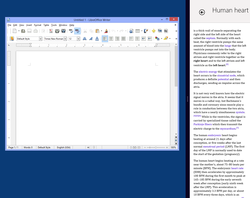This article needs to be updated. The reason given is: The article omits latest developments such as the newest name ("packaged apps") and related technologies such as AppContainer, AppSilo, WinUI 3, MAUI, and MSIXVC. Changes in Windows 11 aren't covered..(July 2024) |


Right: Metro-style app; entirely composed of contents
Universal Windows Platform (UWP) apps [1] (formerly named Windows Store apps, Metro-style apps and Modern apps) [2] are applications that are built on the Universal Windows Platform. They are primarily purchased and downloaded via the Microsoft Store, Microsoft's digital application storefront [3] and can be used across all compatible Microsoft Windows devices since Windows 8. UWP stopped adding new features in October 2021, [4] but toolchain updates continue to be made. [5]